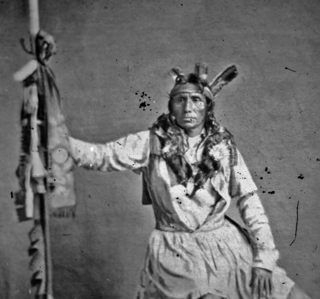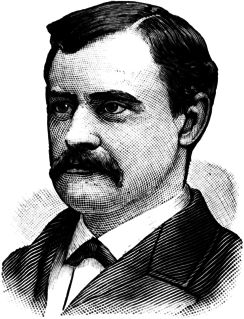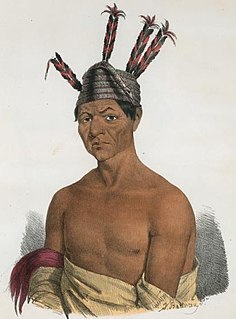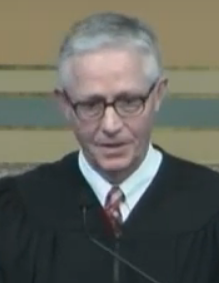
Little Crow III was a Mdewakanton Dakota chief who led a faction of the Dakota in a five-week war against the United States in 1862.
Butter Brickle is a chocolate-coated toffee first sold 20 November 1924 by candy manufacturer John G. Woodward Co. of Council Bluffs, Iowa, and toffee pieces for flavoring ice cream, manufactured by The Fenn Bros. Ice Cream and Candy Co. of Sioux Falls, South Dakota.

Adolphus Washington Greely was a United States Army officer and polar explorer. He attained the rank of major general and was a recipient of the Medal of Honor.

Frank Hatton was an American politician and newspaperman. He was a Union Army veteran of the American Civil War, served as United States Postmaster General, and later edited The Washington Post.

Waukon Decorah, also known as Wakąhaga (Wau-kon-haw-kaw) or "Snake-Skin", was a prominent Ho-Chunk (Winnebago) warrior and orator during the Winnebago War of 1827 and the Black Hawk War of 1832. Although not a hereditary chief, he emerged as a diplomatic leader in Ho-Chunk relations with the United States.

Coe Isaac Crawford was an American attorney and politician from South Dakota. He served as the sixth Governor and as a U.S. Senator.

Martin Nelson Johnson was an American attorney and politician who served as a United States representative and senator from North Dakota.

Henry Sabin was an Iowa educator.

Paul Goble was a British-American writer and illustrator of children's books, especially Native American stories. His book The Girl Who Loved Wild Horses won a Caldecott Medal in 1979.

The Dakota War of 1862, also known as the Sioux Uprising, the Dakota Uprising, the Sioux Outbreak of 1862, the Dakota Conflict, the U.S.-Dakota War of 1862, or Little Crow's War, was an armed conflict between the United States and several bands of eastern Dakota also known as the Santee Sioux. It began on August 18, 1862, at the Lower Sioux Agency along the Minnesota River in southwest Minnesota.

Cyrus Bussey was an American soldier and politician, serving as a brigadier general in the Union Army during the American Civil War.

Keokuk's Reserve was a parcel of land in the present-day U.S. state of Iowa that was retained by the Sauk and Fox tribes in 1832 in the aftermath of the Black Hawk War. The tribes stayed on the reservation only until 1836 when the land was ceded to the United States, and the Native Americans were moved to a new reservation.

Stephen Return Riggs was a Christian missionary and linguist who lived and worked among the Dakota people.

Fred Van Buren Archer was the head football coach for the University of North Dakota Fighting Sioux football team. He compiled an overall record of 2–4. He was born in Vevay, Indiana in 1888.

Edwin Legrand Sabin was an American author, primarily of boys' adventure stories, mostly set in the American West.

Mark Steven Cady was an American jurist. He served on the Iowa Supreme Court for 21 years from 1998 to 2019. From 2011 to 2019, he was the chief justice of the court. He was the author of the court's opinion in Varnum v. Brien, which legalized same-sex marriage in Iowa.

Eagle Woman That All Look At was a Lakota activist, diplomat, trader, and translator, who was known for her efforts mediating the conflicts between white settlers, the United States government, and the Sioux. She is credited with being the only woman recognized as a chief among the Sioux.
Mohamed ben Zamoum was a Kabyle marabout who participated in the Algerian resistance against the French conquest of Algeria.

Sherman Jess Thordsen was an American film and television actor.

Charles L. Hodges was a career officer in the United States Army. A Union Army veteran of the American Civil War, American Indian Wars, Spanish–American War, and Philippine–American War, Hodges remained in the army from 1861 until retiring in 1911 and attained the rank of major general.
This page is based on this
Wikipedia article Text is available under the
CC BY-SA 4.0 license; additional terms may apply.
Images, videos and audio are available under their respective licenses.


















